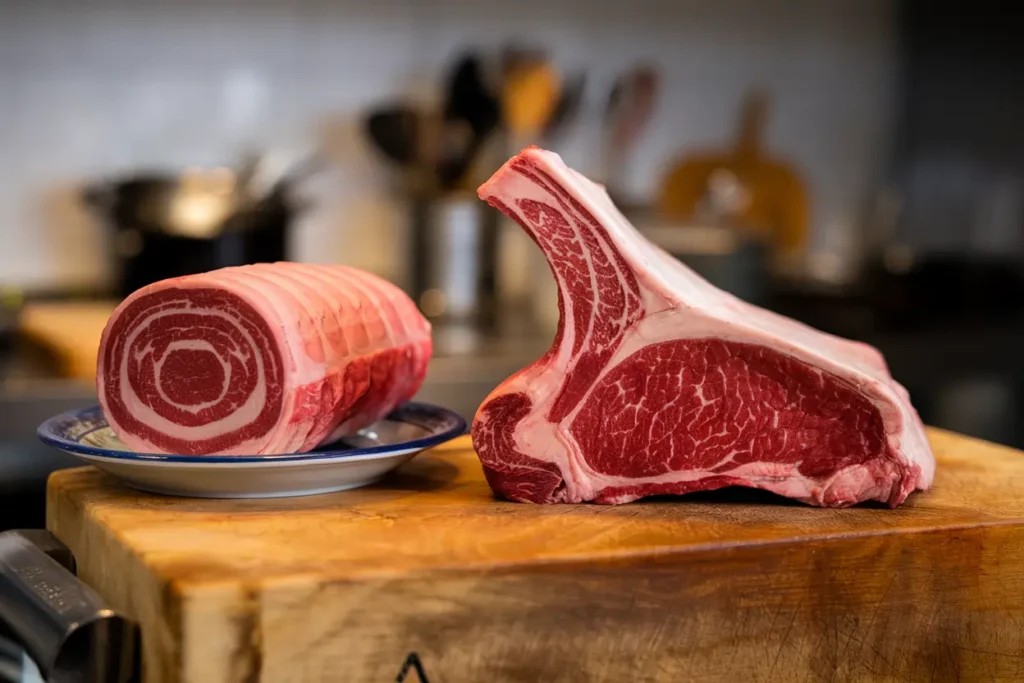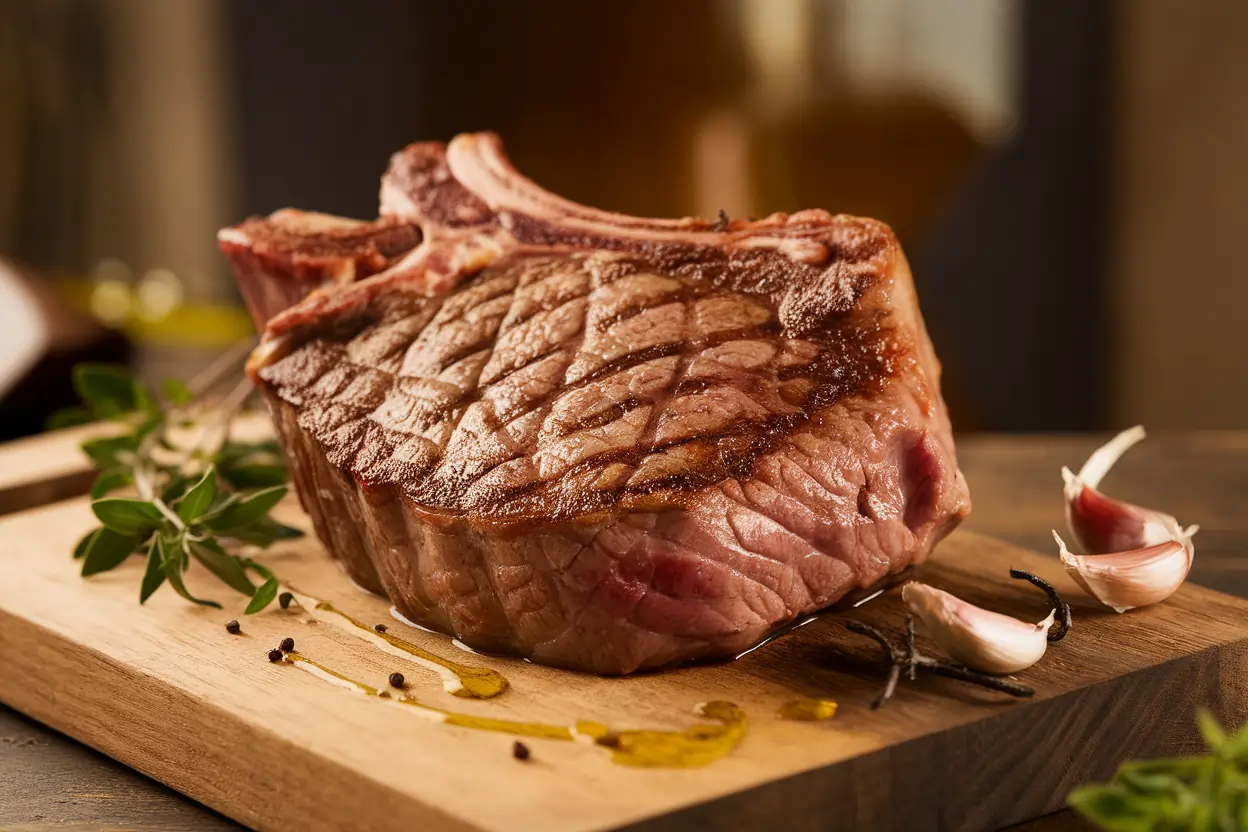Is Rib Cap the Same as Spinalis? Ever wondered if rib cap and spinalis are just two names for the same thing? You’re not alone! These terms pop up in steak recipes, butcher shops, and foodie conversations all the time. But what’s the deal? Are they the same cut, or is there more to the story? Let’s dive into the world of premium beef cuts to clear up the confusion.
Table of Contents
Understanding the Rib Cap and Spinalis
What Is the Rib Cap?
The rib cap is like the crown jewel of the ribeye. Imagine the most tender, flavorful part of a steak—the kind that practically melts in your mouth. That’s the rib cap. It’s the outer layer of the ribeye, sitting atop the central eye of the steak. But don’t let its small size fool you. It packs a punch of beefy flavor and has a buttery, juicy texture that steak lovers dream about.
💡 Fun Fact: The rib cap is often referred to as the “butcher’s secret” because it’s so prized that butchers used to keep it for themselves!
What Is the Spinalis Muscle?

Now, let’s talk about the spinalis dorsi. This muscle is technically a part of the rib cap, but it’s the specific portion that wraps around the eye of the ribeye steak. The spinalis is tender and full of marbling, which means fat is beautifully dispersed throughout the muscle, making it ridiculously flavorful.
💡 Pro Tip: If you’ve ever eaten a ribeye and been blown away by a super soft, fatty piece of meat, you’ve already fallen in love with the spinalis!
Anatomy and Location Differences

Rib Cap: Where It Comes From
The rib cap comes from the rib primal section of a cow, specifically around ribs 6 through 12. Think of it as the outer layer that encases the ribeye muscle. It’s separated from the main ribeye before being sold as its own cut or left attached to the steak for extra flavor.
Spinalis: Its Role in the Ribeye Cut
The spinalis, on the other hand, is a part of the rib cap. It’s the part that curves around the eye of the ribeye, giving it that signature shape and texture. It’s essentially the “meatier” section of the rib cap, and it’s what most people crave when they order a ribeye steak.
Shared Characteristics Between Rib Cap and Spinalis
Here’s where things get a little tricky. The rib cap and spinalis are related, but they’re not exactly the same. It’s like saying a square is a rectangle but not all rectangles are squares. The rib cap includes the spinalis, but it also has other parts of the outer ribeye. Confused? Don’t worry, a good steak will make it all clear! 🍖
Culinary Importance of Rib Cap and Spinalis
Why Chefs Love the Rib Cap
If you ask a chef about their favorite steak cut, there’s a good chance they’ll gush about the rib cap. Why? Because it’s insanely versatile. You can grill it, roast it, or even roll it up into a fancy steak roulade. Its rich marbling ensures it stays tender no matter how you cook it.
Spinalis Muscle: A Steak Lover’s Favorite
Now, the spinalis is like the superstar of ribeye steaks. It’s the reason people pay top dollar for this cut. With its intense flavor and melt-in-your-mouth texture, it’s perfect for anyone who wants a luxurious steak experience. Whether you’re grilling, pan-searing, or reverse-searing, the spinalis shines every time.
Taste and Texture Comparison
So, how do they compare in terms of taste and texture? Both are incredibly tender and rich in flavor, but the spinalis often has a slightly fattier, more luxurious feel. The rib cap, on the other hand, offers a more balanced texture, with a mix of fat and lean meat that appeals to a broader range of palates.
Common Questions About Rib Cap and Spinalis
Are Rib Cap and Spinalis the Same Thing?
Not exactly. Think of the rib cap as the larger piece, and the spinalis as a specific muscle within it. They’re closely related, but not interchangeable. The rib cap includes more meat, while the spinalis is focused on pure, tender deliciousness.
How Are They Sold in the Market?
Rib caps are often sold as specialty cuts in butcher shops or high-end grocery stores. Spinalis, however, is usually left attached to the ribeye steak. If you want just the spinalis, you’ll need to ask your butcher to trim it out for you.
Is One Cut Better Than the Other?
This boils down to personal preference. If you love a fattier, more luxurious bite, go for the spinalis. If you want something with a mix of textures and flavors, the rib cap might be more your speed.
| Feature | Rib Cap | Spinalis |
|---|---|---|
| Location | Outer layer of ribeye | Part of the rib cap |
| Flavor | Rich and beefy | Intense and fatty |
| Texture | Balanced marbling | Super tender |
| Best For | Grilling, roasting | Luxurious steaks |
Cooking with Rib Cap and Spinalis
Best Cooking Methods for Rib Cap
The rib cap is versatile and forgiving, making it perfect for grilling or pan-searing. Want to impress your guests? Roll it up with some garlic and herbs, tie it off, and roast it to perfection. Slice it thin for a mouthwatering presentation that screams gourmet.
How to Cook the Spinalis for Maximum Flavor
The spinalis deserves special treatment. Because it’s so tender, it’s best cooked quickly over high heat. A quick sear on the grill or in a cast-iron skillet will lock in the juices and create a beautiful crust. Finish it off with a touch of butter, and you’re golden!
Tips for Enhancing Flavor and Texture
- Let your meat come to room temperature before cooking.
- Season generously with salt and pepper—simple is best!
- Use a meat thermometer to ensure perfect doneness.
- Rest your steak for 5–10 minutes before slicing to keep it juicy.
Rib Cap vs. Spinalis: Pros and Cons
Benefits of Rib Cap
The rib cap is like the Swiss Army knife of premium beef cuts. Its versatility makes it a go-to choice for chefs and home cooks alike. Whether you’re grilling, roasting, or even slow-cooking, the rib cap delivers exceptional flavor every time. Plus, its balanced marbling ensures it stays tender without being overly fatty.
💡 Did You Know? Rib caps are often sold as a specialty item in high-end butcher shops because of their limited availability.
Benefits of Spinalis
If indulgence had a flavor, it would taste like the spinalis. This cut is all about luxury, offering unparalleled tenderness and a rich, buttery flavor that’s hard to beat. It’s perfect for steak lovers who want the ultimate dining experience.
Drawbacks to Consider
While both cuts are incredible, they’re not without their challenges:
- Rib Cap: Its scarcity means it can be expensive and hard to find.
- Spinalis: Its high fat content may not appeal to everyone, and it’s usually sold as part of the ribeye, making it harder to isolate.
Buying and Storing These Premium Cuts
Where to Find Rib Cap and Spinalis
Not every grocery store stocks rib cap or spinalis, so your best bet is a local butcher or specialty meat shop. Online meat retailers are another excellent option, offering premium cuts delivered right to your door. Keep an eye out for labels like “rib cap,” “cap steak,” or “spinalis dorsi” to ensure you’re getting the real deal.
Tips for Selecting the Best Cuts
When shopping for these cuts, here’s what to look for:
- Marbling: More marbling means more flavor, so aim for cuts with a good balance of fat and meat.
- Color: Look for bright red meat, indicating freshness.
- Smell: A clean, neutral aroma is key—anything off might mean the meat isn’t fresh.
Proper Storage to Maintain Quality
To keep these premium cuts at their best:
- Store them in the coldest part of your fridge, ideally below 40°F (4°C).
- If you’re not cooking them within a day or two, wrap them tightly in butcher paper or vacuum-seal them for freezing.
- Use frozen cuts within 3–6 months for optimal flavor and texture.
FAQs and Misconceptions
Are Rib Cap and Spinalis Only for Steak Enthusiasts?
Not at all! While they’re a favorite among steak connoisseurs, anyone who loves tender, flavorful meat will appreciate these cuts. They’re easy to cook and practically foolproof, making them perfect for both beginners and seasoned chefs.
Do They Come from the Same Animal Part?
Yes, both cuts come from the rib section of the cow. However, the rib cap is a larger section that includes the spinalis, which is a specific muscle within the rib cap.
Can You Substitute One for the Other?
You can, but it depends on the recipe. The rib cap’s slightly leaner texture makes it more versatile, while the spinalis is best for dishes that highlight its rich, fatty flavor.
| Nutrient | Rib Cap (4 oz) | Spinalis (4 oz) |
|---|---|---|
| Calories | 320 | 350 |
| Protein | 25g | 24g |
| Fat | 25g | 30g |
| Saturated Fat | 10g | 12g |
| Iron | 15% | 12% |
When exploring the differences between premium beef cuts, understanding similar gourmet options can broaden your culinary knowledge. For instance, if you’re curious about how other steak cuts like bavette compare in flavor and preparation, check out the guide on exploring the delights of bavette steak. Additionally, steak enthusiasts often benefit from learning about versatile cuts such as chuck eye, which is discussed in detail in the ultimate guide to beef chuck eye steak. For a comprehensive comparison of ribeye variations, consider reading is chuck eye steak the same as ribeye?. These resources enhance your understanding of rib cap and spinalis while guiding you through the world of premium beef.
Conclusion: Celebrating the Best of Both Cuts
Why Rib Cap and Spinalis Are Culinary Stars
Whether you’re team rib cap or team spinalis, there’s no denying that both cuts are absolute showstoppers. They each bring something unique to the table—literally! From the rib cap’s versatility to the spinalis’ unmatched tenderness, these cuts elevate any meal to gourmet status.
Final Thoughts on Their Differences and Similarities
At the end of the day, rib cap and spinalis aren’t so different. They’re two sides of the same delicious coin, offering a premium steak experience that’s hard to beat. So, the next time you’re at the butcher shop, why not grab one of each and decide for yourself? Your taste buds will thank you. 🍴

